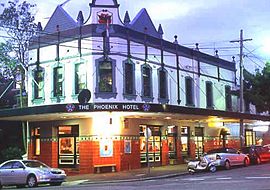Woollahra, New South Wales
|
Woollahra Sydney, New South Wales |
|||||||||||||
|---|---|---|---|---|---|---|---|---|---|---|---|---|---|

Phoenix Hotel, Moncur Street
|
|||||||||||||
| Coordinates | 33°53′S 151°15′E / 33.883°S 151.250°ECoordinates: 33°53′S 151°15′E / 33.883°S 151.250°E | ||||||||||||
| Population | 7,180 (2011 census) | ||||||||||||
| Postcode(s) | 2025 | ||||||||||||
| Location | 5 km (3 mi) east of Sydney CBD | ||||||||||||
| LGA(s) | Municipality of Woollahra | ||||||||||||
| State electorate(s) | Sydney, Vaucluse | ||||||||||||
| Federal Division(s) | Wentworth | ||||||||||||
|
|||||||||||||
Woollahra is a suburb in the Eastern Suburbs of Sydney, in the state of New South Wales, Australia. Woollahra is located 5 kilometres east of the Sydney central business district, in the local government area of the Municipality of Woollahra. The Municipality of Woollahra takes its name from the suburb but its administrative centre is located in Double Bay. Woollahra is famous for its quiet, tree-lined residential streets and village-style shopping centre.
Woollahra is an Aboriginal word meaning camp or meeting ground or a sitting down place. It was adopted by Daniel Cooper (1821–1902), the first speaker of the legislative assembly of New South Wales, when he laid the foundations of Woollahra House in 1856. It was built on the site of the old Henrietta Villa (or Point Piper House). Cooper and his descendants were responsible for the establishment and progress of the suburb and its name was taken from the house.
Woollahra was the home of John McGarvie Smith, a metallurgist and biochemist who produced the first preservable anthrax vaccine.
Among the cafes and restaurants are a number of antique shops and art galleries. The suburb is also the location of many government consulates, including Serbia, Germany, Russia, Poland and Turkey.
One of the more prominent churches, All Saints in Ocean Street, was designed by Edmund Blacket and built from 1874–1881. Henry Mort, a resident of Ocean Street, donated £3,000 towards the construction of the church. However, the church was never entirely finished; it includes a porch that was meant to be a base for a tower and spire, which was designed but never built. It is constructed predominantly of dressed sandstone and is now listed on the Register of the National Estate. It has been described as "a beautifully designed and crafted parish church that has important connections with many famous Australian families."
...
Wikipedia

